Description
The CLIP-tag protein labeling system enables the specific, covalent attachment of virtually any molecule to a protein of interest. CLIP-tag is a protein tag based on human O6-alkylguanine-DNAalkyltransferase (hAGT). CLIP-tag substrates are derivatives of benzylcytosine (BC). In the labeling reaction, the substituted benzyl group of the substrate is covalently attached to the reactive cysteine of CLIP-tag forming a stable thioether bond. Although CLIP-tag is based on the same protein as SNAP-tag®, the benzylcytosine substrates form a separate class of substrates, different from the benzylguanine substrates recognized by SNAP-tag. CLIP-tag and SNAP-tag can be used for orthogonal and complementary labeling of two proteins simultaneously in the same cells.
There are two steps to using this system: subcloning and expression of the protein of interest as a CLIP-tag fusion, and labeling of the fusion with the CLIP-tag substrate of choice. The use of BTC during the labeling of fusion proteins with CLIP-Cell substrates is described in this document.
Figure 1: Structure of CLIP-Cell Block (MW 286.1)

- This product is related to the following categories: